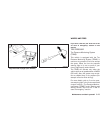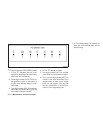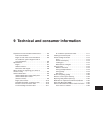
studded tires. Skid and traction capabilities of
studded snowtireson wetor drysurfaces maybe
poorer than that of non-studded snow tires.
TIRE CHAINS
CAUTION
Only certain SAE class “S”tire chains can
be used on this vehicle. Using the wrong
Class “S” chains on this vehicle will cause
damage to the vehicle. If you plan to use
tire chains/cables, you should use a tire
chain that meets the minimum clearances
for your vehicle.
Use of tire chainsmay be prohibited according to
location. Check the local laws before installing
tire chains. Wheninstalling tire chains, makesure
they are the proper size for the tires on your
vehicle and are installed according to the chain
manufacturer’s suggestions. Use a tire chainthat
is designed to provide the specified space
᭺
A
between theinstalled tire chain
᭺
1
and wherethe
tire meets the rim
᭺
2
as shown on the chart.
Wheel size Minimum space required
16 in .7 in (17 mm)
A tire chain that provides thespecified amountof
space will provide the necessary clearance be-
tween the tireand the closest vehicle suspension
or bodycomponent. Theminimum clearancesare
determined using the factory-equipped tires.
Other types may damage your vehicle. Use chain
tensioners when recommended by the tire chain
manufacturer to ensure a tightfit. Loose end links
of the tire chain must be secured or removed to
prevent the possibility of whipping action dam-
age to the fenders or underbody. If possible,
avoid fully loading your vehicle when using tire
chains. In addition, drive at a reduced speed.
Otherwise, your vehicle may be damaged and/or
vehicle handling and performance may be ad-
versely affected.
Tire chains must be installed only on the
front wheels and not on the rear wheels.
Never install tire chains on a TEMPORARY USE
ONLY spare tire.
Do not use tire chains on dry roads. Driving with
tire chains in such conditions can cause damage
to the various mechanisms of the vehicle due to
some overstress.
LDI0574
Maintenance and do-it-yourself 8-37


















